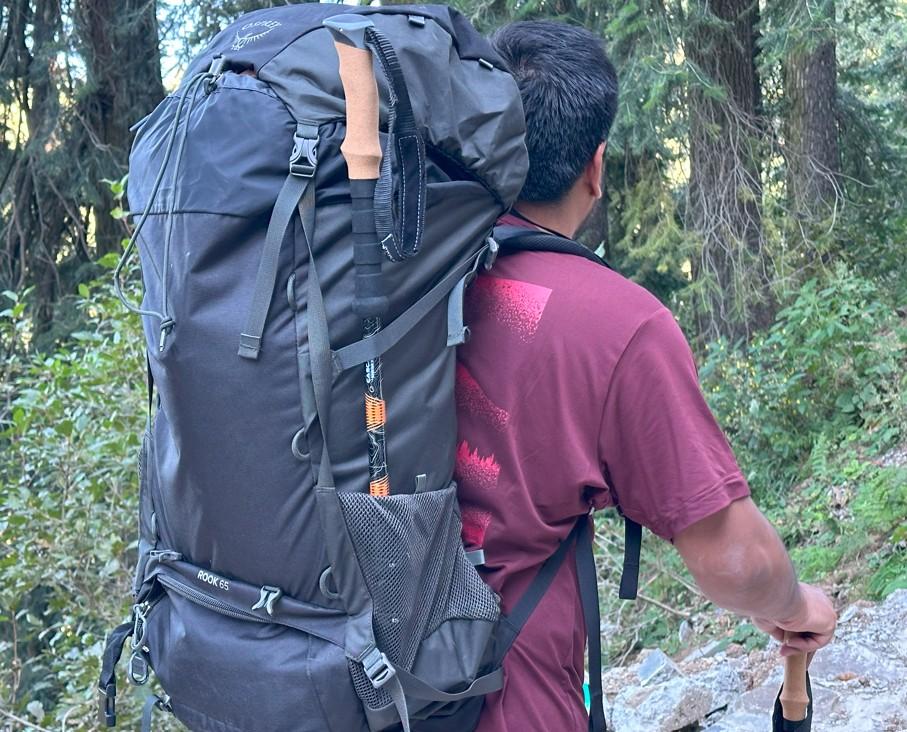Carbon fiber vs. aluminum trekking poles—which one should I choose?
It’s a simple choice that depends on the balance between weight, durability, and cost. Carbon fiber poles are lighter, which suits long treks or if you want to carry light poles. They also absorb shock better. Aluminum poles are heavier but more durable and affordable.
If you want comfort on the trail, then go with the carbon fiber poles, which are lighter. They are good if you are going for long hikes (backpacking) or mountainous terrain as long as you can afford them. Aluminum poles are tough; they don’t break under huge pressure, but they can bend. For average trekkers, they do more than enough on the trail, that too at a budget-friendly option.
Related: Best Budget Trekking Poles
I used both carbon fiber and aluminum trekking poles for years in the backcountry. In this article, I’ll compare carbon fiber and aluminum trekking poles. I’ll look at how they perform in key areas like weight, price, and durability. You’ll see the pros and cons of each.
Carbon Fiber Trekking Poles
What is carbon fiber?
Carbon fiber is a strong, lightweight material made mainly of carbon atoms. Carbon atoms form long, thin fibers. These fibers are usually 5 to 10 micrometers wide. It has a strong strength-to-weight ratio. This makes it a great choice for lightweight support and outdoor gear.
Pros of Carbon Fiber Trekking Poles
Carbon fiber is popular in sports gear. It has a great strength-to-weight ratio, plus it’s stiff and durable. When we hike, we like to use lighter gear.

This helps us avoid getting tired before finishing the trail. The carbon trekking poles are lightweight. In general, the following are some of the key benefits of carbon trekking poles:
- Lightweight (easy to carry)
- Durable
- Good at shock absorption
- Stiff
- Better Performance on Uphill/Downhill
- Good Grip and Comfort
- Compact
Carbon trekking poles absorb shock and support body weight when climbing uphill. Similarly, they are stiff. The stiffness gives strength against up and down forces. So, you can lean on the trekking poles without bending.
Carbon trekking poles are perfect for long-distance trails. They are strong and durable. They are also five times stronger than steel and, at the same time, lighter than steel.
Cons of Carbon Fiber Trekking Poles
Carbon fiber trekking poles have many benefits, but they also have some downsides. Here’s a list of the cons:
- Higher Cost
- Brittleness (can break instead of bending).
Carbon fiber poles are brittle. The carbon fiber’s stiff nature causes the pole to be vulnerable to breaking. This is not as common as you might think. I hardly ever hit them on the rock, which can damage the poles. You have to pay more money to buy carbon fiber poles compared to aluminum poles.
Aluminum Trekking Poles
What is aluminum?
Aluminum (a chemical element) is one of the most common metals in the world. Aluminum is a chemical element that exists in nature, unlike carbon fibers. It is best used as an alloy. It is non-corrosive and has a low density; hence, it is lightweight.
Pros of Aluminum Trekking Poles
Aluminum trekking poles are popular. They are strong, durable, and affordable.
Here are the key pros of aluminum trekking poles:
- Durable
- Affordable
- Strength
- Tolerant of cold and heat.
- Easy to Repair
- Corrosion Resistance
If you want to buy budget trekking poles, then it’s recommended to go with the aluminum poles.
Aluminum is cheaper than carbon fiber trekking poles. It has a low density, which still makes it lighter than most metals. It is also resilient in harsh conditions and does not break, unlike carbon fiber. They bend under high pressure instead of breaking, so you can repair them with little effort.
Cons of Aluminum Trekking Poles
Aluminum trekking poles have many benefits. But they also have some downsides compared to carbon fiber poles.
Here are a few cons of aluminum trekking poles:
- Heavier Weight
- Less Shock Absorption
- Lower Stiffness
- Prone to scratching
Aluminum is a bit heavier than carbon fiber poles. That’s why most backpackers prefer to take carbon fiber poles. I take carbon fiber poles on most of my hikes (even for short hikes) due to their lightweight.
Occasionally I take my cheap aluminum poles, especially when I am not carrying much load on my back. I also noticed they don’t absorb shocks well. This makes them uncomfortable on rough and rocky terrain. They bend under heavy pressure, which can be risky if you are hiking downhill, as you may fall.
Key Differences: Carbon Fiber vs. Aluminum
Weight Comparison
Manufacturers keep both carbon fiber and aluminum trekking poles light as much as possible. However, carbon fiber is lighter than aluminum trekking poles.
Related: One or Two Trekking Poles
That’s why you will see most serious hikers (especially backpackers) spend extra bucks to cut the weight of the poles.

I never felt the need to pack them in the backpack when I didn’t need them. I just fold them and keep them in my hands when I don’t want to use them on easy trail patches. Still, I don’t feel uncomfortable when I take carbon fiber poles instead of aluminum.
For instance, a typical carbon fiber road bike frame weighs around 700-800 grams, but an aluminum frame of the same size usually weighs between 1,200-1,400 grams. That’s why, if you want better pole performance, then try to cut the weight that carbon fiber poles offer.
Strength and Durability
Carbon fiber is strong yet light. It can handle stress well, so it’s a great choice for outdoor gear and sports equipment, like tennis rackets and golf clubs.
However, like I mentioned earlier, it is brittle compared to aluminum. That means it can break under high pressure, especially if you hit against rocks or trees.

Aluminum poles don’t break but bend under pressure so you can recover them easily. Even though they are much heavier than carbon fiber, in the long run, they are a durable option. .
Price
When we look at prices, carbon fiber trekking poles cost more than aluminum ones. Do you know why carbon fiber poles are more expensive than aluminum? That’s because of high raw material costs and an advanced manufacturing process. So they are also labor-intensive, which contributes to the cost.
For instance, carbon fiber poles can range from $100 to $200, but you can get the aluminum poles for as low as $25.
So why not go with the cheaper one? Well, for regular and occasional hikers, aluminum poles are more than enough. He does not need to spend extra bucks to get the expensive carbon fiber pole models. If you are a more serious and long-distance hiker, then you should buy carbon fiber poles, which are ultralight. They provide much better comfort than aluminum and increase your hiking performance.
Terrain Suitability
The trekking poles suit different groups based on their preferred terrain. For casual hikers, aluminum poles may be the best for them.

They can handle occasional impacts well without breaking the bank. Long-distance hikers should use carbon fiber poles. They are lighter, making them easier to carry on the trail.
Related: Best Wood for Hiking Stick
If you hike in extreme conditions, carbon fiber trekking poles will absorb shocks better.
Conclusion
Carbon fiber and aluminum trekking poles each have their pros and cons, as we discussed in this article. Carbon fiber poles cost more, but they are light and strong. This makes them ideal for long-distance trekkers and ultralight hikers. I never felt the vibration while using carbon fiber poles than the aluminum poles. Aluminum poles are stronger, but they are also heavy. If you are on a budget, aluminum poles can be your best bet as long as you are not an ultralight hiker. Whichever material you choose, knowing How to Use Trekking Poles properly makes all the difference.
Related: Do You Really Need Trekking Poles
